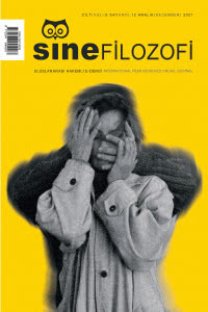Sinema Filmlerinde Estetik Haz, Bellek Ve Özneleştirme İlişkisi: “Brand New Testament” Filminin Ontolojik Analizi
Sanat, insanlık tarihinin mücadele alanlarından birisidir. İmgesel alanda devam eden bu mücadeleye 19. yüzyılın sonlarından itibaren sinemanın da dâhil olduğunu biliyoruz. Estetik bir objenin, estetik bir süjenin bedeni üzerindeki etkisini ise bahsedilen imgesel mücadele alanında “estetik haz” kavramı ile tanımlamaktayız. Estetik haz kavramının anlaşılır olması ve üzerinde felsefi bir tartışmanın yapılabilmesi ise ontolojik açıdan estetik objenin bir bilgi nesnesi olarak kabul edilmesi ile ilgilidir. Bu kabul sonrasında estetik objenin, estetik süje üzerinde yaratacağı tasarlanmış bir etkiden söz etmeye başlayabiliriz. Bu çalışmada estetik hazzın sanatçı tarafından tasarlanmış düşüncelerle meydana getirilmek istenen bir duygulam olduğu ifade edilmektedir. Estetik haz kavramı, genel haz kavramının tanımlarını bir hayli aşarak toplumsal alanda özneler üzerinde yaratılan çok boyutlu bir etkiyi anlatmaktadır. Bu bağlamda çalışmanın amacı estetik hazzın varoluşunun, bellek ve özneleştirme kavramları ile ilgisini ortaya koymaktır. Çalışmanın son kısmında ise “Brand New Testament” isimli film, estetik felsefesi ve estetik haz kapsamında değerlendirilmiştir. Değerlendirmede kullanılan yöntem estetik objelerin varoluşlarının anlaşılması için tercih edilen ontolojik analizdir. Bu yöntemle filmin yönetmeninin oluşturduğu kasıtlı imgeler üzerinden yani ön ontolojik tabaka vasıtasıyla tasarımdaki bellek ve özneleştirici unsurlar ortaya çıkarılmak istenmektedir.
The Relationships Between Aesthetics Pleasure, Memory and Subjectivation in Cinema Films: The Ontological Analysis of the Film “Brand New Testament”
Art has been one of the arenas of the human history. We know that cinema was included in this struggle taking place in the imaginative field after the end of nineteenth century. We define the effect of an aesthetic object on the body of an aesthetical subject with the concept of aesthetical pleasure in the aforementioned imaginative field of struggle. Making the aesthetical pleasure understandable and conducting a philosophical discussion on it is related to accepting and aesthetical object as an object of information in terms of ontology. After accepting this, we can start to mention about a designed effect of the aesthetical object on an aesthetical subject. In this study, it is stated that aesthetical pleasure is an affectivity which was formed with the thoughts designed by the artist. The concept of aesthetical pleasure extremely exceeds the general definition of pleasure and describes a multi-dimensional effects created on subjects in social field. Within this context, the objective of the study is to reveal the relationships between the existence of the aesthetical pleasure and the concepts of memory and subjectivation. In the final chapter of the study, the film “Brand New Testament” was analyzed in terms of philosophy of aesthetics and aesthetical pleasure. The method employed in the evaluation is the ontological analysis which was preferred to understand the existence of aesthetical objects. Through this method, it is desired to reveal the memory and subjectivating elements in designs through the intentional images created by the director of the film, namely, through pre-ontological layer.
___
- Assman, J. (2001). Kültürel Bellek, çev. Ayşe Tekin, İstanbul: Ayrıntı Yayınları.
- BERGSON, H. (2014). Gülme: Gülüncün Anlamı Üzerine Deneme, çev. Devrim Çetinkasap. İstanbul: Türkiye İş Bankası Kültür Yay.
- Bonnard, A. (2014). Antik Yunan Uygarlığı-3. Ankara: Evrensel Basım Yayın.
- Bozkurt, N. (2013). Sanat ve Estetik Kuramları.İstanbul: Sentez Yayıncılık.
- Brümmer, K. (2018). Subjectivation By Video:Ethnographic Explorations On Practices Of Video Analysis In High-Performance Youth Football. German Journal Of Exercise And Sport Research, 48(3), 358-365.
- Buxton, R. (2016). Yunan Mitolojisi, çev. Ahmet Fethi Yıldırım. İstanbul: Alfa Basım Yayım.
- Cicovacki, P. (2015). The Analysis Of Wonder: An Introduction To The Philosophy Of Nicolai Hartmann. USA: Bloomsbury Publishing.
- Cooper, D. E., Margolis, J., & Sartwell, C. (1992). A Companion To Aesthetics. Oxford, UK: Blackwell.
- Erzat, A. (1997). Mitoloji Sözlüğü. İstanbul: Remzi Kitapevi.
- Deleuze, G. ve Guattari F. (2001) Felsefe Nedir?, çev. Turhan Ilgaz, İstanbul: Yapı Kredi Yayınları.
- Fraser, I. (2008). Hegel ve Marks İhtiyaç Kavramı, çev. Beyza Sumer Aydaş, Ankara: Dost Kitabevi.
- Gadamer, H. G. (2009). Hakikat ve Yöntem. çev. Hüsamettin Arslan ve İsmail Yavuzcan. İstanbul: Paradigma Yayınları.
- Gombrich, E. H. (2007). Sanatın öyküsü, çev. Erol Erduran ve Ömer Erduran. İstanbul: Remzi Kitabevi.
- Hartmann, N. (2010). Ontolojinin Işığında Bilgi. İstanbul: Türkiye Felsefe Kurumu.
- Hartmann, N. (2014). Aesthetics. Berlin: Walter de Gruyter GmbH & Co KG.
- Kagan, M. (1993). Estetik ve Sanat Dersleri, çev. Aziz Çalışlar. Ankara: İmge Yayınevi
- Messadie, G. (1998). Şeytanın Genel Tarihi, çev. Işık Ergüden. İstanbul: Kabalcı Yayınevi.
- Neu, J. (2000). A Tear İs An İntellectual Thing: The Meanings Of Emotion. UK: Oxford University Press.
- Nietzsche, F. (2005). Tragedyanın Doğuşu, çev. Mustafa Tüzel. İstanbul:İthaki Yayınları.
- Nita, B. F. (2014). Intentional Image And Transcendental Image In The Work Of Art: An Ontological Analysis. Akademeia, 4(1), ea0124.
- Paras, E. (2016). Foucault: Öznenin Yitiminden Yeniden Doğuşuna, çev. Yunus Çetin. İstanbul: Kollektif Kitap.
- Schudson, M. (2007). Kolektif Bellekte Çarpıtma Dinamikleri. Cogito, 50, 179-199.
- Solomon, R. C. (2004). Thinking About Feeling: Contemporary Philosophers on Emotions, Oxford: Oxford University Press
- Spinoza, B. (2011). Etika, çev. Hilmi Ziya Ülken, Ankara: Dost Kitabevi.
- Şenel, A. (1996). Siyasal Düşünceler Tarihi. Ankara: Bilim ve Sanat Yayınları.
- Tunalı, İ. (1973). B. Croce Estetik’ine Giriş. İstanbul: İstanbul Üniversitesi Edebiyat Fakültesi Yayınları
- Tunalı, İ. (1996). Estetik. İstanbul: Remzi Kitabevi.
- Timuçin, A. (2004). Felsefe Sözlüğü, İstanbul: Bulut Yayınları.
- Viladesau, R. (1999). Theological Aesthetics: God In Imagination, Beauty, And Art. New York: Oxford University Press.
- Zizek, S. (2015). Hiçten Az: Hegel ve Diyalektik Materyalizmin Gölgesi. İstanbul: Encore Yayınları.
- Yayın Aralığı: 2
- Başlangıç: 2016
- Yayıncı: Serdar Öztürk
